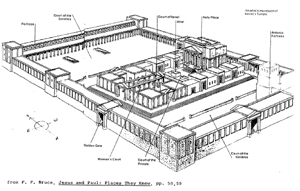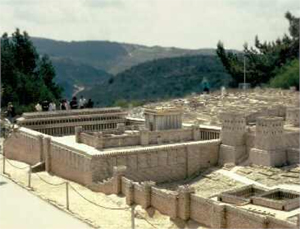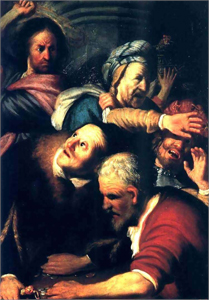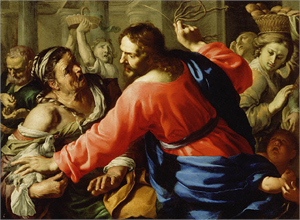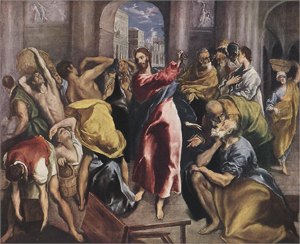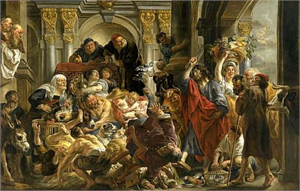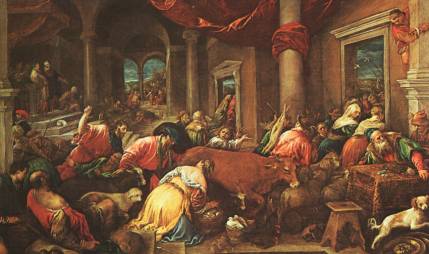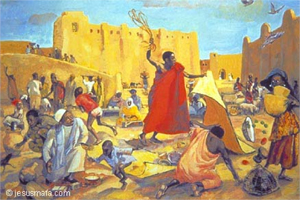
Christmas
Easter
Pentcoest
All Saints
Christ The King
Confirmation
Palm/Passion
Reformation
Stewardship
Books of the Bible
Lenten Series
Christmas Dramas
Videos
Series A - Matthew
Series B - Mark
Series C - Luke
Series D - Other
To contact
Edward F. Markquart
info@sfs.com

Series B The Cleansing of the Temple LENT 3B John 2:13-22 An illustration. Mom and Dad (my wife and myself) had gone on vacation and had asked their oldest daughter to check on the family house to make sure everything was OK. The oldest daughter’s name was Anne. She had a husband named Steve, and two children, Ben and Kate. One day, after Grandma and Grandpa had been gone for almost a week, it was time to drive over to the house and make sure that everything was OK. As the Dunham family drove up to Grandma and Grandpa’s house, they sensed that something was wrong. It just didn’t feel right. It was eerie. A strange sensation made the family feel uneasy. Something was wrong. Daughter Anne unlocked the door and she peered into the front room. It was a mess. Her husband Steve was right behind her and then the two kids. Someone had been into Grandma and Grandpa’s house and totally vandalized it. Ransacked it. Destroyed it. Weird senseless things. All the furniture in the living room was turned over, shaving cream and paint sprayed all over the living room and dining room and kitchen. Lipstick scrawled across the walls. The cupboards in the kitchen had been opened and all the dishes were scattered on the floor and broken into a mess of glass. The whole house that had been vandalized. The living room, dining room, kitchen, family room, bedrooms. Drawers had been dumped. The large colored television set was gone. So was the computer. So was the silver. So was the jewelry box. Yes, they robbed the house. More than that, they destroyed the house. And this eldest daughter, her husband and their children were so mad. So angry. They reported it to the police. But there was nothing they could do. They telephoned Grandma and Grandpa to tell them what happened to their house and they, too, were mad as hops. Yes, insurance covered some of the damage…but it was…just so awful. What a mess. Yes, there are times when we become intensely angry. Such as when our home has been senselessly robbed, vandalized, destroyed and desecrated when we are gone on vacation. Such as wartime, when some guerillas slip in from the jungle and mutilate your family and home. Such as when the enemy’s bombers come in and decimate your town and all the homes in your village. Yes, there are times in our lives as human beings that we become intensely angry. Those times may be the angriest times of our lives. Yes, there are times in our lives as human beings that we become intensely angry. We also think of times when sacred objects were desecrated such as the crazed man throwing a solvent at Michelangelo’s famous carving, the Pieta, the most beautiful carving in history, and trying to destroy it. Or a crazy person who slashes the canvas of a famous painting by Rembrandt and scar it forever. Some people are mentally and morally sick and do terrible things to sacred objects. We are profoundly disgusted by the desecration of holy things. In the text for today, we hear the story of the day when Jesus was the angriest he ever was as a human being. Today’s story is when Jesus was so mad and so angry and so hostile that he pulled out a whip. Have you ever been that mad? What was going on in the story for today that made Jesus so incensed. People were vandalizing Jesus father’s house and he was made, plenty mad. Just as daughter Anne was enormously angry that people had vandalized her parent’s home, so Jesus was also extremely angry that someone was ruining his Father’s home. Jesus caught them right in the act of their vandalizing, right in the act of their profaning, right in the act of their ruining his Father’s house. No wonder Jesus was so mad. Let’s take a careful look at the Biblical story for today and see what we can learn. 12 After this he went down to Capernaum with his mother, his brothers, and his disciples; and they remained there a few days. It was eighty miles from Capernaum to the capital city of Jerusalem. Capernaum was Jesus’ hometown in adulthood and located on the northern end of the Sea of Galilee. 13 The Passover of the Jews was near, and Jesus went up to Jerusalem. Circle the world, “Passover.” All four gospel authors tell the story of the cleansing of the temple. All four gospel authors have this event occur just before the Passover. Only John explicitly mentions the Passover. In the first three gospels, the cleaning of the temple occurs as part of the Passover week. Passover was celebrated annually in the springtime, in either March or April. Passover attendance was required. It was required that every male would make at least one pilgrimage to Jerusalem to participate in the Passover. Passover time was the greatest festival of the Jews. Hundreds of thousand of pilgrims would have been in Jerusalem for that feast. Can you imagine the mob, the mass of humanity, the never ending pushing and shoving crowd? Passover time meant chaos in the city, a week’s vacation for the kids and their parents. A spring vacation for a week. It was Passover time and the city was jammed. It was like a mob at Mardi Gras. Just jammed. And you were there. The hockers were hocking their wares, “Lambs for sale. Lambs for sale.” “Good deal on matzo. Matzo here in our tent.” “Come and have your Passover dinner with us. Great food.” What a mad house. Dirty streets and dusty mules. Dusty streets and dirty mules. Camels baying off in the distance. Pilgrims chanting their prayers. Roman chariots and Roman charioteers riding back and forth. Just like it the movies with John Wayne and Charlton Heston and Cecil B. DeMille, and they were all there. What a mad house. What a mess. But it was a great week for business and a great week for making money. And the kids? They loved all the commotion. The reputation of Jesus had already spread. You see, just before, Jesus Christ had produced his first mighty miracle, the turning of water into wine, and people had heard about it and wanted to see more miracles. People always want to see miracles, one more sign by the happy Houdini of the Holy Land. But in the story for today, he was not so happy. 14 In the temple Focus on the phrase, “in the temple.” This event is called the Cleansing of the Temple. In the first three gospels, the cleansing of the temple by Jesus occurs during Holy Week during his last week in Jerusalem. In the gospel of John, the cleansing occurs at the very beginning of his ministry. The practice of selling sacrificial animals did not occur within the temple itself but within the temple courtyard or the Courtyard of the Gentiles as seen in the diagram below. The courtyard was large, perhaps the size of two or three football friends. In the diagrams, find the Gentile Courtyard. Use your imagination. Imagine thousands of people crammed in and around the temple and sacrificial animals being sold and money changers all around the Gentile Courtyard. Try to imagine the chaos of so many people shouting and buying animals.
he found people selling cattle, sheep, and doves, and the money changers seated at their tables. We can easily visualize the money chargers, the oxen, sheep, pigeons and the general chaos in the Temple area, especially in the Court of the Gentiles. We recall that the historian Josephus informed us about the “bazaars of Annas.” We recall that Annas was the old man, the high priest, and that he had four sons and one son-in-law (Caiaphas) who were also high priests. This family made big money off the temple business. It was the biggest racket in town. People would bring their Roman and Greek coins with images of the emperor on those coins. Such coins were inadmissible in the temple because they were unclean due to the pagan image of the Caesars on those coins. Those coins with the image of Caesar would have to be exchanged for Jewish “kosher” coins. The money-changers made good profits. Larger animals like oxen and sheep were also bought and sold, as were pigeons for the sacrifices for poorer people. The costs of sacrifices were inflated fifteen times. That is, a pilgrim would pay a dollar for a lamb outside the temple and $15 for a lamb inside the temple grounds. This practice was plain and simple extortion. In equivalent dollars of today, Annas had an annual $170 million dollar business going. Yes, Annas and his high priestly family, had the best and biggest business in the country, and it was concentrated in the temple. 15 Making a whip of cords, he drove all of them out of the temple, both the sheep and the cattle. Underline the phrase, “making a whip of cords.” Jesus was really mad, so mad that he mad a whip. Jesus was furious. The Gospel of John often gives us graphic little details and this gospel gives us the graphic of Jesus making a whip out of cords. By “all,” it seems that Jesus drove both the people and the animals out of the temple. Jesus drove out the sellers of the animals, the money changers and the animals. Jesus was cleaning house of them all. He also poured out the coins of the money changers and overturned their tables. Those money changers must have been upset, to have their bags of money poured out on the floor. And then Jesus overturned their tables. It feels as if Jesus was on a rampage, does it not? There was a plurality of money changers and money changing tables and Jesus overturned them. Jesus didn’t mess with one money changer and one table. No, the words are plural. 16 He told those who were selling the doves, "Take these things out of here! Carefully examine the next paintings. What do you see? http://membres.lycos.fr/imagedart/images/mc11a/index.htm REMBRANDT
Congregation, what do you see? Immediately you focus on the eyes of Jesus. In this Rembrandt, the viewer cannot help but focus on the stern and angry eyes of Jesus. He has a whip in his right hand. The man next to Jesus is clutching his money bag. A viewer also focuses on the money at the bottom left. The man is grabbing his loose change so as not to lose it. We know that this was the day that Jesus was the angriest he was during his whole lifetime. In all five paintings below, Jesus is wearing red, as a symbol of red hot anger. In all five paintings, Jesus has a whip in his right hand, and the whip (only mentioned in the Gospel of John) is another symbol of red hot anger. http://www.getty.edu/art/gettyguide/index.html BERNARDINO MEI
Congregation, what do you see in this painting? Where do you primarily focus? What are the secondary focuses? In the above painting, we focus on the figure of Jesus dressed in red and an older woman on the left. We immediately see Jesus right hand with its whip and his left hand pushing a pigeon from a commonly woman’s right arm. We recall the story of the pigeon sellers. We notice a man behind her counting his money to make sure that he didn’t lose any. Behind the older woman with the wrinkled skin, we see a woman with an ashened face of fear carrying a basket of birds in her outstretched hands, trying to make sure that she didn’t lose any. We notice a well dressed woman on the right with a basket of bread carried on her head. The painting is filled with tension. Because we know the story, we know that Jesus is going on a rampage, driving all of these people and their merchandise out of the temple. http://www.wga.hu/frames-e.html?/html/g/greco_el/1575/09trader.html EL GRECO
We again focus on Jesus (dressed in red) in the center of the painting. We can see the elongated bodies that is characteristic of the style of El Greco. We can see the money changer on the upper left, clutching his bag of money. As Jesus utilizes a whip, it appears that he is using the whip to intimidate people who are selling goods in order to move these people out of the temple. We can see a table turned over in the foreground. http://www.louvre.fr/francais/collec/peint/inv1402/peint_f.htm The above link has a fascinating conversation about this painting. JACOB JORDEANS
On a larger screen, a person can see the detail in this picture e.g. the pigeons at the bottom in the pigeon cage. In the center bottom, a viewer can see a man being turned over in a chair such as when Jesus turned over the chairs of the pigeon sellers. You can see a cow/oxen (center) and a donkey (left0 which apparently were being sold. The scene is pure chaos. Jesus was dressed in red with a whip in his right hand. http://cgfa.sunsite.dk/b/p-bassano2.htm BASSANO
Again, in this painting, a viewer can get the feeling of the chaos of the scene. Numerous people are trying to escape from the anger of Jesus (again dressed in the color red that symbolizes his hot anger): money changers, men, women, sheep, cows, dog, pigeons. The movement is for people trying to get out of the temple. We are reminded that these scenes of the temple presuppose Jesus was in a temple building and not out in a courtyard adjacent to the temple. A viewer gets the feeling of a marketplace right within the temple. http://www.jesusmafa.com/anglais/imag48.htm AFRICAN MAFA
In all six paintings, Jesus was wearing red, as a symbol of red hot anger. In all five paintings, Jesus has a whip in his right hand, and the whip (only in the Gospel of John) is another symbol of red hot anger. Stop making my Father's house a marketplace!" This is the key. Underline it. Highlight it. Emphasize it. Why was Jesus so angry? Because people were desecrating his Father’s house. Jesus was thinking of God as his Father and that his Father’s house had been violated. Jesus is saying that the Lord God is his Father and that this temple is his Father’s house. The people and priests were making God’s house a marketplace, a store to buy and sell animals for sacrifices, a ATM machine to get cash to use for offerings. When our own homes have been broken into, robbed, vandalized and violated, we naturally become intensely angry at those destructive thieves who have ransacked our houses. We feel personally violated. We often become intensely angry at those people who have smashed up and defaced our homes and committed wanton, destruction of our property. Similarly, Jesus thought of the temple as his Father’s house and it was being vandalized and violated, defaced and destroyed by people who did not respect or revere the Lord God. The gospels of Matthew, Mark and Luke use a different Bible verse which says about the same thing, “Is it not written (in the Old Testament, my house shall be called a house of prayer for all nations? But you have made it a den of robbers.” Isaiah 56:7 d. Write in the margin near the word, “marketplace.” My house shall be called a house of prayer for the nations but you have made it a den of robbers.” 17 His disciples remembered that it was written, "Zeal for your house will consume me." This is a quotation from Psalm 69:10. Circle the word, “zeal.” Zeal implies intense passion. Focus on the two words, “your house.” The temple was and is the Lord’s house. It is not that the Lord God confined his presence to the temple but that that temple had been dedicated to God. The house was the Lord’s house. “Consume me.” Eat me up. Devour me. 18 The Jews then said to him, "What sign can you show us for doing this?" The Gospel of John was the book of signs. Signs were miracles that pointed to God. In John’s gospel, the previous event was the sign of turning the water into wine. The masses of humanity at the Passover had heard about the miracle of Jesus turning water into wine and they wanted to see if he could do another. The synoptic gospels do not have this section in John 2:18-22. 19 Jesus answered them, "Destroy this temple, and in three days I will raise it up." Jesus was forever challenging the Jews. Jesus was playing on words. The temple that he would raise was his own body rather than the physical temple that had taken nearly five decades to build. 20 The Jews then said, "This temple has been under construction for forty-six years, and will you raise it up in three days?" The construction of the temple began in 20 BCE so this would have been about the year 26 CE. If Jesus was born in about the year of 6 BCE, he would have been about thirty years old at the time of this event. The temple was completed in about the year 63 CE. But the dating of the temple and dating of the age of Jesus was not the major issue of this text. Rather, Jesus’ body would be raised up in three days. Jesus was referring to his resurrection. But the crowds did not comprehend what Jesus was saying. They did not realize at that moment that Jesus was talking about God being his Father, that this was his Father’s house, and that the Lord God would raise him on the third day. 21 But he was speaking of the temple of his body. Jesus’ body was a temple and so is ours. Our body is the temple of the Holy Spirit. 22 After he was raised from the dead, his disciples remembered that he had said this; and they believed the scripture and the word that Jesus had spoken. It was only after Easter and the resurrection, when the disciples thought back about the unforgettable incident of Jesus cleaning the temple, that they recalled he had prophecied that his body would be raised on the third day. They were so caught up in the chaos of the cleansing that they had not focused on his teaching that his body would be raised on the third day. In other words, way at the beginning of Jesus’ ministry, Jesus had prophecied that the Lord God would pull off the mightiest miracle of all and raise him from the dead. That concludes the Bible study for today. So what does this story about the cleansing of the temple mean to us today? What can we learn from this incident? First, we see that Jesus got mad, mighty mad, as angry as a person can be, so much so that he made of whip of cords and drove the money changers out of the temple. We know that Jesus was the Son of God, the personification of perfection, the model of excellence, yet Jesus got mighty mad. We need to let Jesus’ full humanness simmer within us. Jesus didn’t get mighty mad when he didn’t get his own way. That is what we often do when we don’t get our own way, but this was not the cause of Jesus’ anger. Jesus didn’t get mighty mad when he was tired, exhausted and all worn out. That is what we often do when we are tired and exhausted. But this was not the cause of Jesus’ anger. Jesus didn’t get mighty mad when someone step on his ego, his pride, his professional vanity. That is what we often do when someone stomps on our pride, hurts our feelings. But this was not the cause of Jesus’ anger. Rather Jesus got mighty angry inside when he saw injustice and irreverence. He got might mad when he saw people charging inflated prices for sacrificial animals and when he saw how people were desecrating the temple, his Father’s house. He got mighty mad when he saw their lack of deep respect and reverence. Righteous anger. We need to talk about righteous anger. We call Jesus’ anger, righteous anger, good anger, healthy anger. Some examples of righteous anger? When people are deeply angry at something that is wrong. For example, Abraham Lincoln was angry at slavery. That was righteous anger. Martin Luther King, Jr. was angry at racial discrimination. That was righteous anger. Nelson Mandela was angry at apartheid in South Africa. That was righteous anger. There is always a time and a place for righteous anger. In our personal, day to day, lives when we see any form of injustice, it makes us mad inside. There are so many examples of injustice that we can’t count them. Some simple examples are when we see a bully beating up on a young kid, when we see a thief stealing an old woman’s purse, when we see a group of girls being catty and mean to another girl at recess, when a husband beats up his wife. The list goes on and on. The Lord God has wired us in such a way that most healthy human beings are angry inside when we see evil and injustice being done to someone. This is called righteous anger. We are angry at evil and injustice, just as Jesus was angry that day in the temple when he saw all the injustices of people selling sacrifices at inflated prices. However, there is not only righteous anger which is good. There is unrighteous angry which is bad. Such as temper tantrums that we throw when we don’t get our own way, such as when other people step on our egos, such as when other people have different ideas of the way things are to be solved than we have. This anger is sinful anger. I sense that we as human beings get angry way to much, way too often, that our emotional fuses are set off much too easily. One thing that most of us human beings are working on is our tempers and temper tantrums. This wasn’t Jesus problem, but it is our problem. In today’s Bible story, Jesus was angry at injustice (dishonest dealings) and irreverence (lack of respect for God and the things of God.) But this wasn’t the end of the story about his anger. We are suspicious that many of these same people who were in the temple selling goods at unjust prices were also at the cross on Good Friday, watching him being crucified. Jesus prayed to God, “Father, forgive them, for they don’t know what they are doing.” A second thing that we learn from this story is that Jesus was upset with folks who didn’t treat the temple with sacredness and reverence. Even though Jesus clearly understood that the Presence of God was not confined to a “god box” called the temple; in the story for today, Jesus also demonstrated his respect and reverence for the temple, for the building, for the bricks and mortar which had been dedicated to God. Jesus venerated the temple as being his Father’s house. We too are invited to respect our temple, our sanctuary, our place of worship here in our little city, even though we realize the Lord God is not confined to living in such a man-made place. In the story for today, we are invited to realize that Jesus wants our sanctuary to be a house of prayer for all nations. In our sanctuary, our worship service is a time of prayer and praise. A time when we worship the Lord God, when we pray for ourselves and all people around the globe, when we pray not only for our national leaders but for the leaders of all nations of the world. Our sanctuary is to be a house dedicated to prayer. When we hear the word, sanctuary, we think of prayer. Prayer to God. Prayer with God. Prayer in the Presence of God. That is what Jesus wanted temples to be: places of prayer. Nowadays, our sanctuaries are not usually marketplaces where we sell animals for sacrifices. But often nowadays, we have unconsciously converted our sanctuaries into chat rooms and social halls. Far to often, our sanctuary becomes one more chat room and one more fellowship hall, where the fellowship is not primarily between the Lord God and ourselves but the fellowship is between friends sitting together in the same pew. Somehow, in the busyness of the conversations within casual sanctuaries and in our attempts to appeal to modern young people, it seems that often we forget that our sanctuaries are to be places of prayer. That is what Jesus said a temple was: a place of prayer for all nations. In our busy social world of the twenty first century, it seems that the Presence of God is persistently being moved to the margins and to the sidelines. Even within our temples, people have often forgotten how to pray to God but simply chat with other people seated around them. In the modern world, temples have often degenerated into chat rooms, not with God but with each other. Yes, the story of the cleaning of the temple is a great story from which we can learn much. To be honest, we can’t quite get the image of Jesus with a whip in his hand out of our minds. In the story for today, we can visualize the eyes of Jesus being blazing hot, with a whip in his hands, overturning the tables of the money changers and driving the sellers and their sacrifices from the temple. We can see Jesus cleaning up the temple. Yes, we all have to come to grips with that day when Jesus of Nazareth was “might mad,” when he was the angriest in his whole life. Amen. |
